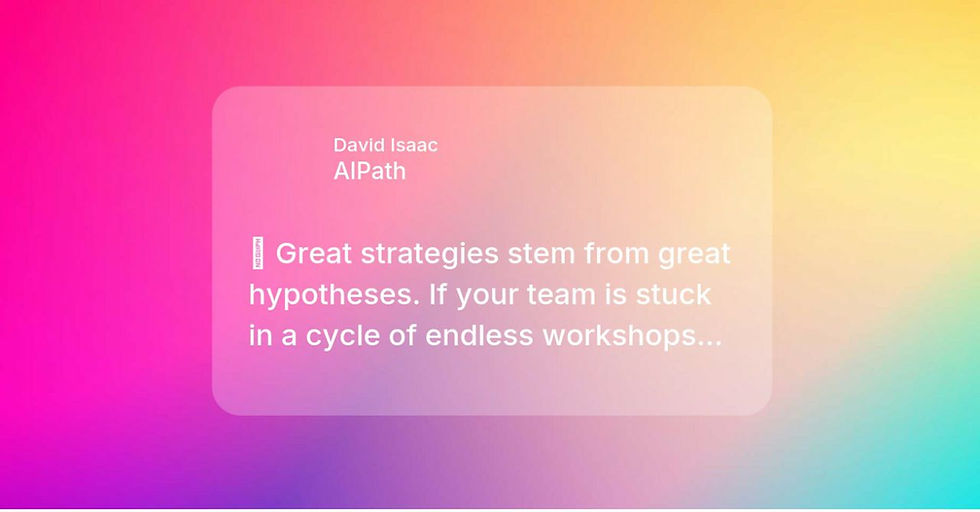The Hacker, Hipster, Hustler according to the Business Model Canvas
- David Isaac
- Aug 27, 2023
- 4 min read
Updated: Sep 18, 2023
TL;DR

Solo and tech founders: Pay attention. Assembling a startup dream team isn't a luxury—it's a necessity for success. The Hacker, Hipster, and Hustler roles can be aligned to the Business Model Canvas and the path to traction.
This world first linkage between these concepts turns the concept of the dream team into a prescriptive tool you can use as you grow, when you need to expand the team and help you get to product-market fit despite tough odds.
Table of Contents
Why This is Crucial for Solo and Tech Founders

If you're a solo or tech-focused founder, you might excel in one of these roles but lack competencies in others. And while you may have a compelling business idea, the absence of essential skill sets can lead to a flawed business model and even failure. The convergence of the Hacker, Hipster, and Hustler within the Business Model Canvas is not just an intriguing concept—it's a framework that fills these skill gaps strategically. As we've elaborated in our article Key Reasons Startups Will Fail to Get to Their Next Fundraising Milestone, such gaps can significantly hinder your progress.
The Business Model Canvas: A Refresher

Before diving into the roles, let's revisit the Business Model Canvas (BMC). This strategic management tool helps you map, discuss, and design your business model with a focus on the customers job to be done in a structured way.
Do Startups Really Understand the Quarter-Inch Hole When Designing a New Business Model? discusses this in detail. The BMC consists of nine basic building blocks that cover the four main areas of a business: customers, offer, infrastructure, and financial viability.
Key Components:
Customer Segments
Value Propositions
Channels
Customer Relationships
Revenue Streams
Key Activities
Key Resources
Key Partnerships
Cost Structure
The Benefits of Using the Business Model Canvas as an iterative Strategy Tool:
Real-time business assessment.
Opportunities for strategic alignment.
Focused strategy development.
Many people use the BMC as a decriptive tool. When used at an expert level, it's a forward looking and prescriptive tool that helps you spot gaps and be more (strategically) agile.
Connecting these two concepts turns theory into a prescriptive tool for a bias to action.
Melding the Hacker, Hipster, and Hustler archetypes into your startup's DNA and aligning them within the Business Model Canvas framework gives you a tool that helps you identify the skills that you need to help your startup go all the way. This novel alignment of these two concepts can redefine how startups think about team-building and business design.
Deep Dive into the Business Model Canvas
For those unfamiliar, the Business Model Canvas (BMC) isn't just a template; it's a comprehensive strategic tool that transforms business variables into actionable insights. We're not just producing marketing fluff when we build a BMC; we're expressing our true strategy in an articulate and deliberate way to align departments, roles, and examine where we need deeper thinking or where iteration needs to happen to get to product-market fit.
At it's best and most prescriptive, it's a live document that can evolve with your business. And for the first time, we're decoding how each role in your startup fits into the BMC like never before.
The Roles: Hacker, Hipster, Hustler
The Hacker: Your Technical Backbone
Relevance: Hackers bring the technical prowess that turns your business idea into an actual product or service.
BMC Alignment: Key Activities and Key Resources.
For more on this, refer to our Ultimate Guide to Growth Strategy and Positioning.
The Hipster: The Creative Genius
Relevance: Hipsters ensure your product isn’t just functional but also appealing and user-friendly.
BMC Alignment: Customer Segments and Value Propositions.
For creative strategies, see 3 Tips for Growth in 2023: Growth Strategy Depends on Where You Are in Your Lifecycle.
The Hustler: The Business Mind
Relevance: Hustlers are the ones who sell your product, focusing on the market aspects of your venture. BMC Alignment: Channels, Customer Relationships, and Revenue Streams.
For a deeper look into market strategy, refer to Your Practical Guide to Understanding Your Growth Equation for How to Win in the Market.
Linking these roles and responsibilities with the Business Model Canvas
How do these roles interact within the BMC framework? Let's break it down.
Key Activities & Key Resources: The Hacker, especially, plays here but intersects with the Hustler when considering which technological assets can be monetized.
Value Propositions & Customer Segments: This is where the Hacker’s features meet the Hipster’s user experience and focus on customer benefit. The Hustler defines the customer base that would find this value proposition appealing.
Revenue Streams, Channels, and Customer Relationships: Primarily the Hustler's domain, though informed by the Hacker's insights into what can be scaled and the Hipster's understanding of customer needs.
For more on these overlaps, Solving the Puzzle: Understanding the Intersection of CMO & CPO—What You Need to Know in 2023 can be your guide.
Checklist for Actionable Insights
Evaluate your current skill sets and identify gaps.
Refer to the Business Model Canvas for aligning roles and responsibilities.
Seek out potential team members or advisors to fill the identified gaps.
By integrating the Hacker, Hipster, and Hustler roles within the framework of the Business Model Canvas, you can fill essential skill gaps and create a well-rounded, highly capable team. This innovative alignment serves as an actionable guide to propel your startup to new heights.
FAQ
How do I identify which roles are missing in my startup?A skills and responsibilities audit aligned with the Business Model Canvas can help you identify missing roles.
Where can I learn more about each role's responsibilities?Our Workshop Download Pack & Upcoming Monetization Accelerator can provide comprehensive insights.
What if I can’t afford to hire for all these roles?In the early stages, one person may take on multiple roles. However, as the business grows, specialization becomes essential for scaling.









Comments